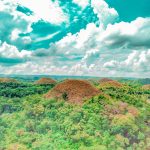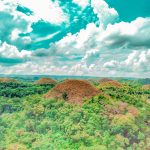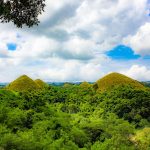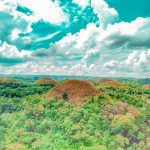Download links
How to install Discovering the Mysterious Chocolate Hills APK?
1. Tap the downloaded Discovering the Mysterious Chocolate Hills APK file.
2. Touch install.
3. Follow the steps on the screen.
Description
The Chocolate Hills, a geological wonder located in the Bohol province of the Philippines, are a striking natural phenomenon that has intrigued scientists and tourists alike. These hills, numbering over 1,200, rise dramatically from the surrounding landscape, creating a unique and picturesque vista. The formation of these hills is attributed to a combination of geological processes, primarily limestone erosion and the effects of weathering.
The region is characterized by its karst topography, which is formed when soluble rocks such as limestone dissolve over time due to the action of water. This process leads to the creation of sinkholes, caves, and, ultimately, the distinctive conical hills that we see today. The Chocolate Hills are believed to have formed during the Pleistocene epoch, approximately 1 to 2 million years ago.
During this time, the area was submerged underwater, and the accumulation of marine organisms contributed to the formation of limestone deposits. As tectonic activity raised the land above sea level, erosion began to sculpt the landscape. Rainwater, rich in carbon dioxide, seeps into the ground and reacts with the limestone, gradually dissolving it and creating the hills’ characteristic shapes.
The hills are covered in grass that turns brown during the dry season, giving them their name. This seasonal transformation adds to their allure, as visitors can witness a landscape that appears to be made of chocolate during certain times of the year.
Key Takeaways
- The Chocolate Hills in the Philippines were formed by the uplift of coral deposits and the action of erosion over millions of years.
- The hills are home to a diverse range of flora and fauna, including endemic species such as the tarsier and the Philippine eagle.
- Local folklore attributes the formation of the hills to a giant’s tears, creating a mystical and enchanting aura around the landscape.
- Conservation efforts and ecotourism initiatives are being implemented to protect the natural beauty and biodiversity of the Chocolate Hills.
- Visitors can enjoy activities such as hiking, bird watching, and exploring the nearby butterfly sanctuary, offering a unique and immersive experience in the area.
Exploring the Biodiversity of the Chocolate Hills
The Chocolate Hills are not only a geological marvel but also a rich ecosystem teeming with biodiversity. The region is home to a variety of flora and fauna that thrive in its unique environment. The hills are primarily covered with grasslands, but they also support a range of plant species, including shrubs and trees that provide habitat for various animals.
Among the notable species found in this area is the Philippine tarsier, one of the smallest primates in the world. These nocturnal creatures are known for their large eyes and remarkable agility, making them a popular attraction for visitors seeking to experience the local wildlife. In addition to tarsiers, the Chocolate Hills are home to numerous bird species, reptiles, and insects.
The diverse habitats created by the varying elevations and microclimates within the hills support a complex web of life. Birdwatchers can spot endemic species such as the Philippine cockatoo and the Philippine eagle soaring above the hills. The presence of these species highlights the ecological significance of the area and underscores the importance of conservation efforts to protect their habitats.
The interplay between geology and biodiversity in the Chocolate Hills creates a dynamic environment that is both fascinating and essential for ecological balance.
The Legend and Folklore Surrounding the Chocolate Hills
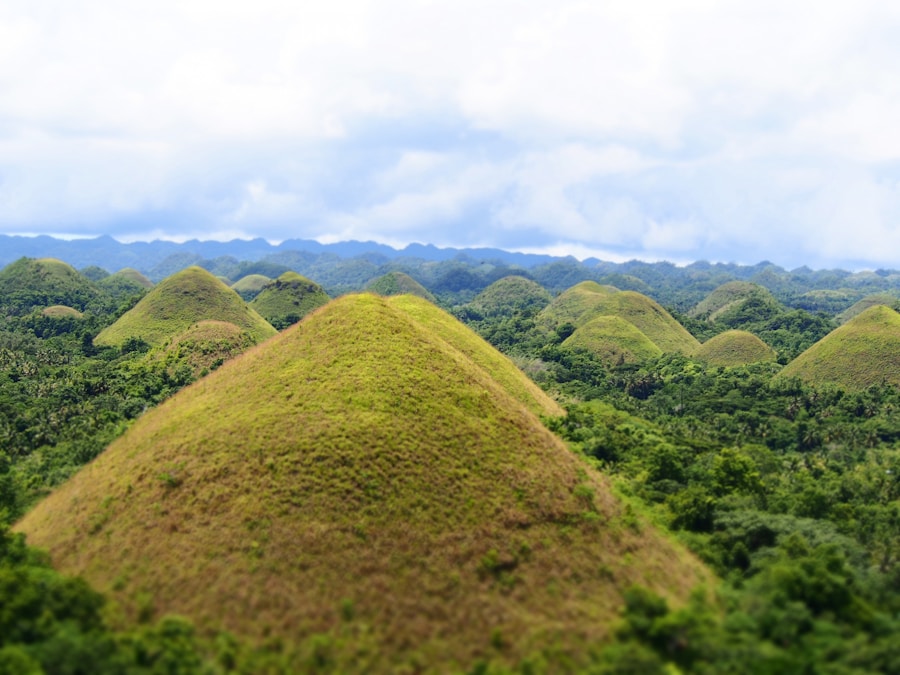
The Chocolate Hills are steeped in local legend and folklore, adding an enchanting layer to their already captivating presence. One popular tale tells of two giants who engaged in a fierce battle, hurling boulders at each other across the landscape. After their fight ended, they left behind the mounds of earth that eventually transformed into the hills we see today.
This story not only explains the hills’ unusual shapes but also reflects the rich cultural heritage of the Boholano people, who have passed down these tales through generations.
His tears formed the hills as they fell to the ground, creating a landscape that symbolizes his sorrow.
This narrative resonates with themes of love and loss, illustrating how natural features can be imbued with human emotions and experiences. Such folklore not only enriches the cultural tapestry of Bohol but also enhances the visitor experience, as tourists are often eager to learn about these stories while exploring the stunning scenery.
Ecotourism and Conservation Efforts in the Chocolate Hills
| Metrics | Data |
|---|---|
| Number of tourists per year | Over 100,000 |
| Percentage of land area dedicated to conservation | 50% |
| Number of endemic species protected | Over 1,200 |
| Number of eco-friendly accommodations | 15 |
| Amount of carbon offset through conservation efforts | Over 10,000 tons |
As awareness of environmental issues grows, ecotourism has emerged as a vital component in promoting sustainable practices in areas like the Chocolate Hills. The influx of tourists seeking to experience this natural wonder has led to increased efforts to balance tourism with conservation. Local authorities have implemented measures to protect the delicate ecosystem while providing visitors with opportunities to appreciate its beauty.
Guided tours often emphasize responsible tourism practices, encouraging visitors to respect wildlife and adhere to designated paths to minimize environmental impact. Conservation initiatives in the region also focus on preserving local culture and promoting community involvement in ecotourism efforts. By engaging local residents in tourism activities, communities can benefit economically while fostering a sense of stewardship for their natural surroundings.
These initiatives not only enhance visitors’ understanding of the Chocolate Hills but also empower local communities to take an active role in protecting their environment for future generations.
Experiencing the Chocolate Hills: Activities and Attractions
Visitors to the Chocolate Hills can engage in a variety of activities that allow them to fully immerse themselves in this breathtaking landscape. One of the most popular attractions is the viewpoint at Chocolate Hills Complex, where tourists can climb a series of stairs to reach an observation deck that offers panoramic views of the rolling hills below. This vantage point provides an excellent opportunity for photography, especially during sunrise or sunset when the hills are bathed in golden light.
For those seeking adventure, ATV rides through the surrounding terrain offer an exhilarating way to explore the area. These guided tours allow participants to navigate through rugged paths while enjoying close-up views of the hills and surrounding vegetation. Additionally, hiking trails have been established for those who prefer a more leisurely exploration on foot.
Along these trails, visitors can encounter local wildlife and learn about the unique flora that thrives in this environment. The combination of adventure and education makes visiting the Chocolate Hills an unforgettable experience for nature lovers and thrill-seekers alike.
The Future of the Chocolate Hills: Challenges and Opportunities

As with many natural wonders around the world, the future of the Chocolate Hills faces both challenges and opportunities. One significant concern is environmental degradation due to increased tourism activity. While ecotourism can provide economic benefits, it also poses risks if not managed sustainably.
Overcrowding can lead to soil erosion, habitat destruction, and disturbances to local wildlife. Therefore, it is crucial for stakeholders—including government agencies, local communities, and conservation organizations—to collaborate on strategies that promote sustainable tourism practices. On a more positive note, there is growing recognition of the importance of preserving natural landscapes like the Chocolate Hills for future generations.
This awareness has led to increased funding for conservation projects aimed at protecting biodiversity and promoting sustainable land use practices. Additionally, advancements in technology offer new opportunities for monitoring environmental changes and assessing the impact of tourism on local ecosystems. By leveraging these tools and fostering community engagement in conservation efforts, there is potential for a balanced approach that allows both tourism and nature to thrive harmoniously in this remarkable region.
If you’re interested in learning more about unique natural wonders like the Chocolate Hills, you may also enjoy reading about the popular homework app, Brainly. This app is a valuable resource for students seeking help with their assignments and studying. Check out this article to discover how Brainly can assist you in your academic journey.
FAQs
What are the Chocolate Hills?
The Chocolate Hills are a geological formation located in the Bohol province of the Philippines. They are made up of around 1,200 to 1,776 conical limestone hills, which are covered in green grass that turns brown during the dry season, giving them a chocolate-like appearance.
How were the Chocolate Hills formed?
The exact formation process of the Chocolate Hills is still a subject of debate among geologists. One theory suggests that they are the weathered formations of a marine limestone on top of an impermeable layer of clay. Another theory proposes that they are the result of the uplift of coral deposits and the action of rainwater and erosion.
What is the significance of the Chocolate Hills?
The Chocolate Hills are a major tourist attraction in the Philippines and are considered a natural wonder. They have been declared the country’s third National Geological Monument and proposed for inclusion in the UNESCO World Heritage List.
Can visitors explore the Chocolate Hills?
Yes, visitors can explore the Chocolate Hills by climbing the viewing deck in the town of Carmen or by taking a guided tour. There are also hiking trails and ATV tours available for those who want to explore the hills up close.
Are there any legends or myths associated with the Chocolate Hills?
According to local folklore, the Chocolate Hills were formed from the tears of a giant named Arogo, who wept over the death of his beloved. Another legend tells the story of two giants who hurled rocks and sand at each other in a fit of rage, and when they reconciled, they left behind the Chocolate Hills.

